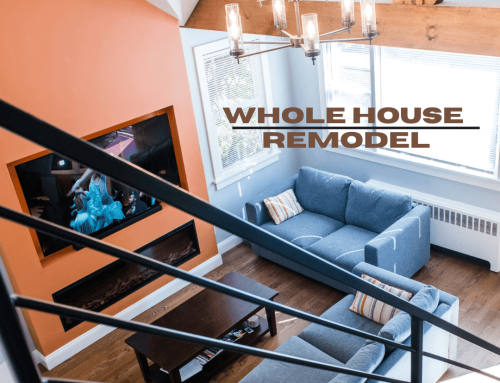AGING IN PLACE.
Designing a Home for Life: Aging in Place with Style and Comfort
As we plan for the future, the concept of “aging in place” has become an essential consideration in home design. More homeowners are looking for ways to create spaces that will support them through every stage of life without sacrificing beauty or luxury. Aging in place design isn’t just about accessibility—it’s about enhancing comfort, safety, and elegance in a way that makes a home timeless.
The Key Principles of Aging in Place Design
A well-designed home for aging in place seamlessly integrates practical features without making them feel clinical. The goal is to create a space that feels just as inviting and stylish as it is functional. Key principles include:
- Universal Design: Features that are beneficial for all ages, such as no-step entries, open floor plans, and wider doorways, ensure accessibility without compromising aesthetics.
- Smart Technology: Voice-activated lighting, smart thermostats, and security systems add convenience while enhancing safety. Alexa, Google Home, and other third-party Matter-capable voice control products can do much more today than they could a few years ago. Incorporating these into designs in a way that feels natural will certainly be beneficial not only to someone who might be disabled but also for overall accessibility.
- Non-Slip, Low-Maintenance Materials: Flooring with texture to prevent slips and surfaces that are easy to clean make daily life simpler and safer.
Room-by-Room Considerations
Kitchen: Beauty Meets Functionality
The kitchen is the heart of the home, and a well-planned space ensures it remains accessible and efficient at every stage of life.
- Adjustable Counter Heights: Consider countertops that accommodate both standing and seated use.
- Pull-Out Shelving & Drawers: These minimize the need to bend or reach, making storage more accessible.
- Kitchen Sink: Lowering the sink and ensuring there are no obstacles underneath allows for wheelchair access. The plumbing needs to be planned accordingly, along with the sink type. There are specific ADA-compliant sinks designed for this application.
- Touchless Faucets & Easy-to-Use Hardware: Lever-style handles and motion-activated features add both convenience and elegance.
- d) Rather than using typical handles on the drawers. Use Servo drives if cost is not an issue, or mechanical Tip ons, useful especially for Arthritis clients.e)Try to keep a lot of the glassware on a lower section of the kitchen rather than the overhead storage.
- Bathroom: A Spa-Like Retreat with Safety in Mind
Modern aging-in-place bathrooms combine luxurious comfort with smart, safe design elements.
- Curbless Showers: Sleek and seamless, these eliminate tripping hazards while maintaining a high-end look. Curbless showers have come a long way. When done well, they not only ensure accessibility but also serve as stylish design features that are increasingly incorporated into modern bathroom designs. This is one area where the benefits extend beyond aging or disabled individuals to everyone.
- Grab Bars That Blend In: Today’s designs include elegant, integrated grab bars that complement bathroom aesthetics rather than stand out.
- Comfort-Height Toilets: Slightly higher seating makes standing and sitting easier while maintaining a polished, sophisticated style.
- A few more examples: In the bathroom, use adjustable shower head for varying height adjustments, use removable hand held rather than a fixed shower head or in combination with a fix showerhead when the home is being use by a lot of family member. Use grab bars in at least two areas in the shower, if there is a choice for only one or the other in terms of a shower or a tub, use the shower with a no threshold so that the owner can roll into it and not climb over anything. Use floating vanities and in cases where you have space, you can do his and hers vanities with different heights.
Living Spaces: Open, Comfortable, and Elegant
- Layered Lighting: A mix of ambient, task, and accent lighting ensures visibility and adds warmth to the space.
- Seating with Support: Stylish yet ergonomic furniture provides comfort and ease of movement.
- Minimal Transitions Between Flooring: Reducing floor height differences minimizes fall risks while keeping the look seamless and modern.
Designing for the Future While Enjoying Today
Aging in place is about creating a home that evolves with you—a place that remains welcoming, luxurious, and practical for years to come. Thoughtful design choices today can provide peace of mind while ensuring a home remains stylish and sophisticated. Whether you’re remodeling or building from the ground up, integrating these elements will make your home a space to enjoy for a lifetime.
Are you considering an aging-in-place design for your home? Let us help bring your vision to life with thoughtful, beautiful solutions tailored to your needs.
Aging in Place vs. Designing for the Disabled
Designing for someone who is disabled requires more specificity and technical considerations to ensure they can live comfortably and navigate the space with ease. The space needs to be designed with all the necessary features to assist that person’s disabilities. While most universal design elements mentioned above can help, additional modifications may be required for someone with specific disabilities.
This topic can be explored in a future post, but generally, additional considerations might include ramps, elevators, stair lifts, shower lifts, and other tailored adjustments to make the home more livable. The key takeaway is not to confuse aging in place with designing for the disabled. While they overlap, they are distinct and require different approaches.
The ADA guidelines specify the space that is needed to be able to turn a wheel chair in a kitchen. Use them, They are crucial to the success of any ADA kitchen designs.
Some old standards are still the staple in kitchen designs, but you have to throw some of them out if you want to design for this new age phenomenon.
This generation Born, Grow up, Get Old update their existing homes and live out the rest of their retirements there.
Questions:
- Would you live in your home at retirement or would you move to an Assisted living facility?
2. Would you rather update your existing home or move to a retirement home?
Love to hear from you.
Services provided by RAJ Kitchen and bath, LLC:
Kitchen Renovation / Kitchen Cabinets /Countertop /Bathroom Renovation
Bathroom Vanities / Custom built-ins/ Closets/ Consultation
Project Management / Kitchen design /Interior design






